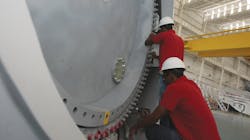Supply Chain Risks Threaten 2020 Renewables Projects
Today, Americans have become accustomed to a life of convenience and relative abundance. We not only enjoy, but tend to expect, luxuries like two-day Amazon Prime delivery, streaming video, and internet access in our daily lives. Very few of us have ever gone to the grocery store to find empty shelves, at least not until lately. Recently, consumers and businesses alike have experienced delays and scarcity in the availability of goods as a result of the novel coronavirus pandemic. These shortages are due to changes in demand, bottlenecks, and other areas of risk that exist in critical supply chains. To help increase supplies of essential items, such as personal protective equipment for healthcare workers, some companies have even increased production lines or reconfigured manufacturing plants.
Electricity is an essential service, and electric utilities routinely prepare for natural and man-made disasters, including pandemics, to ensure the reliability of the grid. On Feb. 5, the NERC Information Sharing and Analysis Center (E-ISAC) issued an announcement related to COVID-19, the disease caused by the novel coronavirus, to address potential supply chain issues stemming from a manufacturing slowdown in Asia and suggested entities review their supply chain risk and business continuity plans. On March 10, NERC then issued a Level 2 alert on contingency planning and asked utilities to file their emergency pandemic plans. The pandemic plans balance employee safety with the provision of reliable electric service.
Supply chain constraints are also affecting renewable resources, including solar and wind. Manufacturing has come to a virtual standstill due to workforce shortages and travel restrictions related to COVID-19. Factories in China are not the only ones feeling the impact of the virus, but so are the overseas module assembly factories that rely on imports of items like frames and junction boxes for solar panels. Developers should expect to see orders delayed at least through the second quarter.
“Late module delivery will affect project construction schedules around the world, and projects with Q3 and Q4 2020 placed-in-service dates are likely to be hit particularly hard,” according to global energy research firm Wood Mackenzie.
The Solar Energy Industries Association (SEIA) estimates that half of the 250,000 workers in the solar industry may temporarily lose their jobs because of the COVID-19 outbreak. SEIA had previously estimated growth of more than 19 GW of new solar capacity in 2020, but has now downgraded the projected growth by about one-third.
However, even with the downgraded growth projections, supply chain disruptions and project delays, industry analysts still estimate overall growth in renewable energy capacity through at least 2021. While there were earlier predictions that new wind installations could be down by up to half in 2020 depending on the length of supply chain interruptions from China, more recent projections by Wood Mackenzie appear more optimistic and indicate that new wind projects may only decrease about 3%. This is because wind turbines are typically constructed in rural areas and many areas have allowed the construction of wind farms to continue as a essential activity. This is also good news for wind developers who are planning to complete projects by the end of the year to qualify for government tax credits and subsidies. Despite the serious global supply chain setbacks due to COVID-19, the long-term growth trajectory of the renewable industry will likely be unaffected. While the renewable energy industry should remain cautiously optimistic, stakeholders should continue to vigilantly monitor the COVID-19 impacts to global supply chains and project installations as the situation continues to evolve daily.
Attorney Joshua Harden with the Stinson law firm provided additional insight into the disruption in the renewable supply chain. Harden dedicates half his practice to state regulatory work for electric utilities and the other half to renewable energy development for a variety of stakeholders, including developers, utilities, landowners, and municipalities. Harden said that information is vital in times of disruption and scarcity. In dealing with an interruption in a global supply chain, it is difficult to figure out the exact point of break. It turns into a mess quickly as businesses start scrambling to find what they need up and down the supply chain. Harden explained that this essentially turns component manufacturing and fully assembled equipment into a spot market. The delivery date on a purchase order will likely get subordinated to spot market pricing during times of extreme scarcity.
Harden also provided tips for companies dealing with a supply constraint. Developers and contractors need to protect themselves with strong force majeure provisions on the construction site of a project. But, on the equipment supply side, one is often dealing with simple purchase orders. In this case, the best protection is understanding as much of the supply chain as possible and communicating regularly with suppliers. Expanding supply optionality and having a back-up plan is critical. Also, due diligence on brokers and manufacturers, starting with insurance coverage, can save a company.
“Finally, I hate to say it, but the squeaky wheel gets the grease during times of major supply chain disruptions. Major supply chain disruptions turn everything into a Thunderdome. It is no time to be a wallflower,” Harden said. “A developer or contractor must be persistent in getting their order filled and properly communicate a cost for not being put at the front of the line.”
About the Author
Martha Davis
Senior Director of Content
Prior to working at T&D World and Utility Analytics Institute, Martha worked as an executive in the energy industry for about 15 years. She has held various regulatory and government affairs positions and had the opportunity to shape public policy.
Martha has a B.A. from Westminster College in Fulton, MO; completed specialized legal and public policy coursework at American University in Washington, D.C.; M.P.A. Public Affairs and M.B.A. Business Administration both from the University of Missouri. She is currently a doctoral candidate at the University of Denver where she is researching business analytics, innovation and regulation.
Kari Embree
Distributed Energy.
